
28 minute read
Specchio di ricordi Lake Resia and the sunken Town
Il sapore dellʼautunno The Taste of Autumn
QUANDO LE FOGLIE INGIALLISCONO E LE GIORNATE SI ACCORCIANO, INIZIA IL PERIODO PREFERITO DAGLI ALTOATESINI: LA STAGIONE DEL TÖRGGELEN. QUESTA USANZA SECOLARE VIENE ANCORA OGGI CELEBRATA ED È CONSIDERATA DALLA POPOLAZIONE LOCALE COME UNO SPECIALE MOMENTO DI CONVIVIALITÀ E DIVERTIMENTO.
Il Törggelen nasce come appuntamento autunnale durante il quale i contadini, dopo la vendemmia, si ritrovavano per assaggiare il vino nuovo. Con il tem po, questa abitudine è diventata una vera e propria festa! Oggi come un tempo, durante il Törggelen si gustano vari sostanziosi piatti tipici accompagnati dal vino nuovo, come: zuppa d’orzo, Kaminwurz e formaggio di malga, crauti e canederli, würstel, carne affumicata, krapfen e caldarroste. Poiché il vino e le castagne sono considerati elementi principali del Törggelen, questa usanza si celebra soprattutto nelle zone dell’Alto Adige dove crescono castagni e viti.
WHEN THE LEAVES TURN YELLOW AND THE DAYS BECOME SHORTER, THE FAVORITE TIME OF THE SOUTH TYROLEANS BEGINS – THE TÖRGGELE SEASON. THE CENTURIES-OLD CUSTOM IS STILL CELEBRATED TODAY AND IS REGARDED BY THE SOUTH TYROLEANS AS A SPECIAL EXPRESSION OF CONVIVIALITY AND HAVING A GOOD TIME TOGETHER.
In its origins, the farmers visited each other after the harvest in autumn to taste the new wine – most of the time it became a party! Törggelen still serves all kinds of hearty food with the new wine today as it did then: Barley soup, Kaminwurze sausages and mountain cheese, dumplings with cabbage, sausages, smoked meat, doughnuts and roasted chestnuts. Since wine and chestnuts are considered the main components of Törggelen, this custom is found in South Tyrol mainly in the areas, where chestnut trees and vines grow.
Castagne e vino sono gli elementi principali del Törggelen. Roasted chestnuts and wine are the main components of Törggelen.

Miss Riesling Ms. Riesling
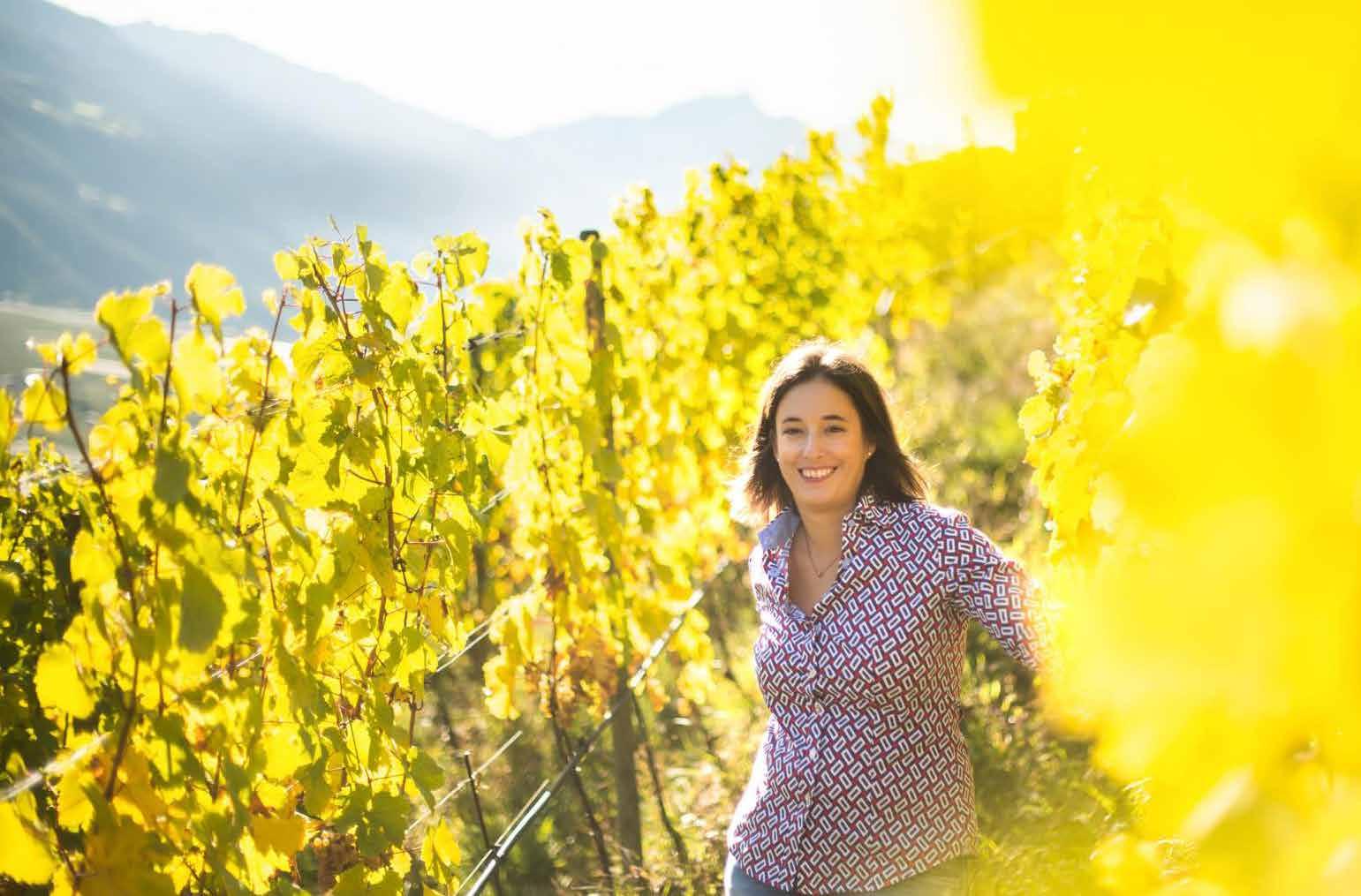
LA VISTA DAL VIGNETO FALKENSTEIN È MAGNIFICA, LE NUVOLE SI MUOVONO VELOCEMENTE SOPRA DI NOI, MENTRE DIETRO DI NOI I RIPIDI PENDII SVETTANO: FORSE CHE UN AMBIENTE COSÌ BELLO RENDA PIÙ FACILE FARE UN VINO DAVVERO BUONO?
Nel vigneto c’è grande attività, la vendemmia è nel suo pieno. Tuttavia, la giovane vignaiola Magdalena Pratzner si prende del tempo per noi e ci racconta com’è essere una delle poche donne in un settore prevalentemente maschile, delle grandi sfide del futuro e del perché il tappo a vite sia così ingiustamente poco apprezzato.
Magdalena, cosa ti piacerebbe che i vostri clienti associassero al nome “Azienda Agricola Falkenstein”? Magdalena: Qualità e un rapporto stretto con la natura. I nostri vini sono prodotti principalmente in vigna e devono riflettere le caratteristiche del terreno. In cantina interveniamo solo quando è veramente necessario. Per noi il vino è un prodotto naturale e nella natura dovrebbe essere creato. Alla base di tutto, ovviamente, c’è la passione: senza questa non si può arrivare da nessuna parte.
Tuo padre Franz Pratzner è considerato un pioniere del Riesling ed è stato addirittura insignito del famoso premio vinicolo Angelo Betti. Questo patrimonio ti mette sotto pressione o ti motiva? No, non sento pressione. Piuttosto, sono orgogliosa di ciò che i miei genitori hanno costruito e realizzato, e del fatto che si fidino di me per continuare questa attività. Per quanto riguarda il Riesling, mio padre ha quasi perfezionato il processo di vinificazione, tanto che posso imparare molto senza particolari incertezze. Per il resto discutiamo molto, ci parliamo e consigliamo. Questa è per me una fase di apprendimento e sono felice di poter contare sulle sue enormi conoscenze ed esperienze. Allo stesso tempo, egli rispetta le mie scelte.
WITH FAST-MOVING CLOUDS AGAINST A CRISP, BLUE SKY AND THE MOUNTAIN SLOPES RISING STEEPLY BEHIND US, THE VIEW FROM THE FALKENSTEIN VINEYARD IS SIMPLY BREATH-TAKING. IN SUCH A BEAUTIFUL SETTING, SHOULDN’T WINEMAKING BE THRIVING AROUND HERE?
Indeed, with the grape harvest in full swing the vineyards are bustling. Despite her heavy workload, winemaker Magdalena Pratzner, takes time off to tell us how she, as a female vintner, manages to operate in what is traditionally a male environment. She discusses the most important challenges of the future as she sees them, and why the screw cap is still frowned upon in some quarters.
Magdalena, how does the “Falkenstein Winery and Vineyard” resonate with wine aficionados? Magdalena: Synonymous with high quality wines, the “Falkenstein” brand has a strong connection with Nature. Our wines are mostly produced in the vineyards, absorbing the nutrients of the soil in which the vine grows. We only intervene in the cellar when absolutely necessary. To us, wine is a natural product and should be largely created in its natural state. But the key to winemaking is: Passion. Without it, you won’t get anywhere.
Your father, Franz Pratzner, is considered a pioneer of Riesling wines and received the coveted “Angelo Betti” Italian award for viticulture. Do you feel that he’s set the bar too high or does his success inspire you? No, I don’t feel any pressure due to his success. I’m proud of what my parents have achieved, and that they have entrusted me with their legacy. When it comes to Riesling, it’s true that my father almost perfected the process. This has taught me a lot and I don’t see a much room for much experimentation in the future. Everything is discussed among us and I receive plenty of advice. For me, it’s a continual learning process and I consider myself fortunate that I can fall back on my father’s extensive knowledge and experience. At the same time, he respects my decisions.
Magdalena e Franz Pratzner Magdalena and Franz Pratzner
L’agricoltura e la viticoltura sono ancora mondi a prevalenza maschili e tradizionali. Da giovane donna, come percepisci questo? Fortunatamente sono sempre stata trattato molto francamente e con rispetto. Ci sono sempre più tenute che vengono rilevate da figlie femmine, anche se è ancora una piccola percentuale. Siamo certamente ancora molto influenzati dalle tradizioni alpine in questa zona e una donna a capo di un’azienda agricola è ancora considerata un’eccezione. Nel resto d’Italia, invece, soprattutto in Piemonte o in Toscana, le donne agricoltrici sono diventate una cosa assolutamente normale. In Alto Adige c’è ancora un po’ di strada da fare. Quello che a molti non piace sentire è che le donne sono ora considerate delle degustatrici migliori (ride). Il cervello femminile sembra essere più sensibile agli aromi, ai sapori e soprattutto alle loro diverse sfumature. Questo naturalmente entra in gioco durante le degustazione, perché le donne hanno un gusto più sviluppato.
Cosa rende la viticoltura altoatesina speciale? Ciò che rende unico l’Alto Adige sono i diversi microclimi e i diversi terreni che si trovano in uno spazio così piccolo. Questo rende possibile un’immensa diversità varietale, che non ho mai sperimentato in nessun’altra regione vitivinicola europea.

The world of agriculture and specifically viticulture, is still very traditional and male-dominated. As a young woman, how do you feel about it? I’m actually treated with a lot of openness and respect. These days, more and more farms are taken over by women and daughters, though admittedly it’s still a small percentage of the total. In this part of the world, we’re still very influenced by Alpine traditions and an heiress is still regarded as something of an oddity. But in other parts of Italy, especially in Piemont and Tuscany, female farm managers are quite common and it’s nothing unusual. I’m sure there’s still scope for progress here in South Tyrol, though I can tell you that women are now considered better tasters and that seems to annoy some people (she laughs). The female brain seems to be more attuned to the different nuances of fragrances and aromas. This affects how one tastes, and women seem to be able to distinguish between a wider range than men.
What’s so special about South Tyrolean viticulture? Throughout its small land mass, South Tyrol has a number of unique microclimates and different soil types. This creates a wide variety of conditions that I haven’t seen in any other European wine-growing region.
AZ. AGR. FALKENSTEIN La viticoltura ha una lunga tradizione a Naturno, ma è stata la ricerca della qualità condotta da Franz Pratzner a collocare la città nelle car te internazionali dei vini. Nel 1989 Franz e sua moglie Bernadette si lanciarono nella rischiosa avventura di trasformare il loro frutteto in un vigneto. Il coraggio ha dato i suoi frutti: la fa miglia Pratzner riempie ogni anno oltre 90.000 bottiglie di vino bianco e Pinot Nero, espor tandolo in Europa, Asia e oltreoceano. Nel 2019 Franz Pratzner è stato insignito del più importante premio vinicolo italiano: il Premio Angelo Betti, che premia tutti quei viticoltori che hanno reso un servizio eccezionale alla viticoltura italiana e alla sua reputazione. Ha ri cevuto il premio per il suo ruolo di pioniere del Riesling, che ha saputo far apprezzare questo tipico vino bianco tedesco in tutta Italia.

FALKENSTEIN WINERY Though wine-making has a long tradition in Naturno/Naturns, it was Franz Pratzner’s drive to produce high-quality wines that placed it on the international winemaking map. In 1989, Franz and his wife, Bernadette, took the first step in that direction, converting what used to be an apple orchard into a vineyard. Today, with an annual production of over 90,000 bottles of whites and Pinot Noirs exported to Europe, Asia and elsewhere, their gamble has paid off handsomely. In 2019, Franz Pratzner received the “Premio Angelo Betti” premier Italian wine award, honouring winemakers who have made an outstanding contribution to viticulture in Italy. Franz Pratzner is recognised for his role as a pioneer of Riesling in Italy, bringing this typical German white varietal to wide social acceptance in the peninsula.
Oltre ai tuoi studi in Austria hai lavorato in cantine negli Stati Uniti, Australia, Francia e Italia. Cosa possono imparare i viticoltori altoatesini dai loro colleghi internazionali? Potremmo imparare, soprattutto, a rilassarci un po’ (ride). A volte ci lamentiamo di cose per le quali i viticoltori italiani o americani, per esempio, alzano semplicemente le spalle. Dovremmo prendere un po’ esempio da loro. Spero che in Alto Adige si possa costruire una tradizione vitivinicola solida come altre in altre parti d’Europa. Sarà importante per noi riuscire a coniugare bene tradizione e innovazione. Molti giovani viticoltori raccolgono esperienze all’estero: questo andrà sicuramente a beneficio dell’Alto Adige.
Quali sono le sfide del futuro per la vostra generazione di viticoltori? Personalmente credo che siano due le grandi sfide che occuperanno la viticoltura altoatesina. Per prima cosa, mantenere costante anche in futuro l’elevata qualità dei nostri vini. L’Alto Adige si è ritrovato catapultato quasi dal nulla sul mercato internazionale in brevissimo tempo. Mantenere questo livello sarà relativamente più difficile che costruirlo. La seconda sfida è rappresentata dal cambiamento climatico.

Following your studies in Austria you’ve worked in wineries in the USA, Australia, France and Italy. What can winemakers from South Tyrol learn from their international counterparts? Most of all, I think we could learn to calm down a little (laughs). We sometimes complain about things that make Italian or American winemakers just shrug their shoulders. We should take things a bit more in our stride. Other than that, I believe we can build a winemaking tradition in South Tyrol as good as any other in Europe, combining tradition with innovation. Many young winemakers gain experience by working abroad, and this can only benefit winemaking in South Tyrol.
What are the main future challenges for your generation of winemakers? I see two major challenges for South Tyrolean viticulture. First of all, I think that producing consistently high-quality wines will be difficult to sustain into the future. South Tyrol has come up from practically nowhere, bursting onto the winemaking scene in a very short space of time. Maintaining this high standard will be a lot more difficult than having gotten there in the first place. Climate change is sure to be another major challenge.
Falkenstein-Riesling è considerato uno dei migliori Riesling a sud delle Alpi.. Falkenstein-Riesling is considered one of the best Rieslings south of the Alps
I vigneti cambieranno? Sì, tra le altre cose. Se le previsioni climatiche si avvereranno, non saprei dire, per esempio, se tra 30 anni ci saranno ancora viti Riesling alla tenuta Falkenstein. I vitigni si sposteranno sicuramente, salendo di quota, forse fino a 1.000 metri di altitudine. A causa degli inverni miti, gli insetti si diffonderanno molto di più e, oltre agli attuali parassiti, arriveranno anche nuovi parassiti, che spesso non hanno un antagonista naturale nel nostro paese.
Concludiamo con un dilemma da risolvere: tappo di sughero o tappo a vite? I tappi a vite sono un must per il vino bianco. I vini bianchi invecchiano bene anche con i tappi a vite, ottenendo comunque una grande freschezza, che li rende davvero interessanti. Con i vini rossi è più complicato. Se si vuole usare il tappo a vite è necessario prevedere in anticipo la maturazione, in modo che i tannini non rimangano troppo amari. Con il sughero, questi si degradano lentamente grazie allo scambio d’aria, con il tappo a vite ciò non avviene o avviene molto più lentamente. Ma il sughero è anche difficile da gestire: in certe circostanze, può privare il vino del suo aroma, ma il sapore sovratannico non è sempre chiaramente attribuibile al sughero. Questo è un problema per la gastronomia, per il sommelier e infine anche per noi viticoltori. Oggi, in tutto il mondo, manca anche del sughero veramente buono e questo probabilmente porterà ad un numero sempre maggiore di tappi a vite.
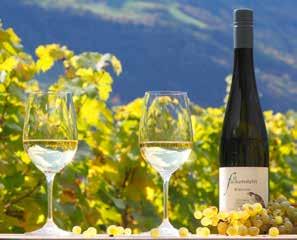
Do you think that grape varietals might change? Possibly. If the climate forecasts are even mildly accurate, I couldn’t be sure if Falkenstein will still have Riesling vineyards in 30 years’ time. As grape varietals change, it will affect viticulture as it moves to higher altitudes, even up to 1,000 m. Insects and other pests will migrate alongside and propagate at higher altitudes during the mild winters. There’ll also be new kinds of invasive species around, without natural enemies to control them.
At the end of the day – will wine lovers stick to cork or will they have to accept screw tops? For white wines, screw tops are now a must. Whites with screw tops age well, retaining freshness and that makes them really interesting. With red wines, it’s more complicated. If you wish to opt for screw tops, you need to be careful when removing air when corking so that the tannins aren’t too bitter. The bitterness slowly subsides through the exchange of air, but with the screw top that doesn’t happen or it happens much more slowly. But cork is also complicated: under certain circumstances, it can deprive the wine of its aroma, though the taste of the skin isn’t always evident due to the cork. This is problematic for those working in gastronomy such as sommeliers, as well as for us winemakers. Really good quality cork is in short supply worldwide and this alone will probably lead to the proliferation of screw tops.
90.000
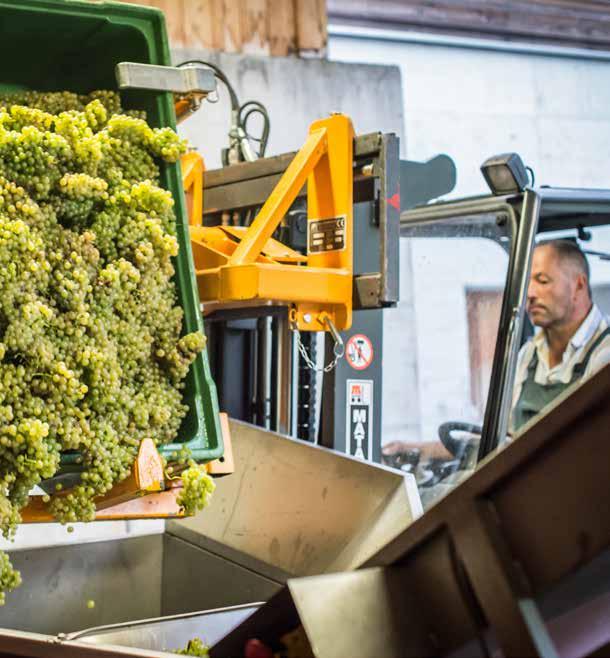
Dai 12 ettari di superficie vitata annualmente si ricavano circa 90.000 bottiglie di vino. The grape vines extend over an area of twelve hectares, producing around 90,000 bottles per year.
In discesa Downhill

Raccontaci -Having a word with... Klaus Nischler, MTB Guide
IL FATTO CHE NATURNO SIA OGGI UNA DELLE MIGLIORI DESTINAZIONI ALTOATESINE PER GLI AMANTI DELLA MTB È IN GRAN PARTE DOVUTO A KLAUS NISCHLER, NATO NEL 1980.
Di formazione falegname, Klaus gestiva la pista da bowling di Naturno insieme a suo padre, fino a quando, dieci anni fa, cercò di professionalizzare la sua grande passione per il ciclismo. Formatosi come guida MTB a Bolzano, ha cominciato a pubblicizzare i suoi primi tour – in principio due, poi tre volte alla settimana – con dei semplici volantini. Oggi è il boss della Ötzi Bike Academy, un‘impresa che comprende: un negozio di biciclette, un noleggio, 16 guide, 25 hotel partner e oltre 20 tour guidati alla settimana per tutte le esigenze.
NATURNO’S RISE TO ONE OF SOUTH TYROL’S TOP MTB DESTINATIONS IS LARGELY THANKS TO KLAUS NISCHLER, WHO WAS BORN IN 1980.
A qualified carpenter, Klaus ran the Naturno/Naturns bowling alley together with his father until ten years ago. He then stuck his neck out and tried to start making a living from his main love: mountain biking. After training in Bolzano/Bozen as an MTB tour guide, he distributed flyers advertising his first tours, which were initially two and later three times a week. Today he heads the Ötzi Bike Academy, which includes a bike shop and rental outlet, a team of 16 MTB guides with a busy schedule of 20 guided tours per week at various proficiency levels and with 25 partner hotels.
Forza muscolare o trazione elettrica? A me piace ancora scalare la montagna con le mie forze, ma il pubblico va decisamente in direzione delle e-bike. Questo ci dà l’opportunità di permettere ad un pubblico più ampio di partecipare ai nostri tour, compresi quelli in montagna. Il piacere è assolutamente in primo piano!
La tua sosta preferita per ricaricare le batterie per la prossima salita? Al maso Bandhof, gustando i loro prodotti! Qui trove - rete solo succhi di frutta naturali, formaggi e insalata dell’orto di questo maso.
Qual è il tuo modo preferito di rilassarti dopo un tour in bicicletta? Standomene a gambe all’aria su una bella terrazza soleggiata, gustando un buon gelato.
Quale sentiero di Naturno credi sia imperdibile? L’Ötzi Trail dalla malga Mauslochalm ha tutto ciò che il cuore di un ciclista può desiderare! Prima si presenta con un bel terreno forestale, poi diventa più tecnico e infine offre un bel “dessert”: l’Ötzi Flow Trail.
Do you prefer leg power or electric drive bikes? I still like to climb the mountain powered by my own muscles, but the trend out there is definitely towards e-bikes. We can cater to a much wider customer base, taking all kinds of people into the mountains. In the end what matters most is to enjoy it!
What’s your favourite rest stop before attempting the next climb? I like the Bandhof Inn with its in-house produce! They serve natural juices, cheese from their own dairy and salads grown on their farm.
After a ride, what’s your favourite way of relaxing? I like to put my feet up on a sunny terrace, with a good ice cream!
Which do you think is the best trail in Naturno? The Ötzi Trail that leads from the Mauslochalm mountain pasture has everything a MTB biker could wish for! It runs through a forest and then becomes more technical before hitting the Ötzi Flow Trail, which is the main attraction.
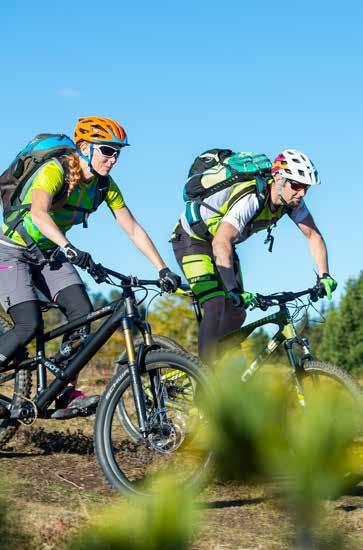
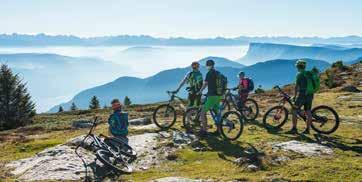
Ötzi Bike Academy La Ötzi Bike Academy è il posto giusto per chi vuole concentrarsi completamente sulla bicicletta. Fondata nel 2006 da Klaus Nischler, è diventata in breve tempo il centro di riferimento assoluto per tutti gli amanti della bicicletta ed è oggi an - che la più grande scuola di ciclismo dell’Alto Adige. Grazie a tour guidati quotidiane, corsi tecnici, negozi, noleggio e officine, ÖBA è il primo punto di contatto per tutti i biker e i ciclisti da strada. Il cuore dell’acca - demia è la Technique Training Area, immersa nel bosco di conifere ai piedi del Monte Tramontana: qui è possibile migliorare le competenze tecniche e raggiungere una maggio - re sicurezza sulla bicicletta. If your interest is cycling/biking, you need look no further than the Ötzi Bike Academy (ÖBA). Founded by Klaus Nischler in 2006, it rapidly grew into the ultimate one-stop biking centre and is now the leading cycling/biking school in South Tyrol. Its daily professionally-supervised guided tours, technical courses, sales & rental outlet and maintenance workshop makes the ÖBA a key reference point for all bikers and racing cyclists in South Tyrol. At the heart of the ÖBA is the Technical Training Area located in a pine forest on the Nörderberg Mountain, whose main purpose is honing down the techni- cal and safety skills of bikers/cyclists.
Con la MTB sulla Monte Tramontana Biking on Monte Tramontana
Naturno, ormai, puó vantare la sua fama in Alto Adige anche come meta ideale per la mountainbike Naturno is one of South Tyrol’s newest MTB destinations, but has so much variety to offer that it has caught up with the front-runners.
Rauher Bühel Naturnser Hochwart Hoher Dieb
VIGILJOCH Seespitz Jocher
Stuanbruch Trail
Aschbacher Hof Naturnser Alm
Zetn Alm
RIOLAGUNDO Unterobereben Funivia Riolagundo Brand RABLÀ BIRCHBERG Uphill Vigiljoch Family-Tour
Brand-Trail Kreuzbrünnl
PARTSCHEILBERG
Uphill Naturnser Alm Mausloch Alm Tablander Alm
Tombergeralm
Bike Highline Merano
MONTE TR AMONTANA
Ötzi-Trail
TOMBERG
Lupo-Trail
PLAUS Waldschenke Marzoner Alm
Niedermairhof
NATURNO
CIRLANO TABLÀ
Info Office San Procolo
STAVA Uphill Tablander Alm Uphill Marzoner Alm
VAL SENALES MONTE SOLE MONTE SOLE Funivia Unterstell Castel Juval Tarscher Joch
Latscher Alm Tarscher Alm
Freiberger Alm Tarscher-Almtrail Seggiovia
FREIBERG
CIARDES Uphill Marzoner Alm
LACINIGO
CASTELBELLO
Questione di cifre Numbers, please!
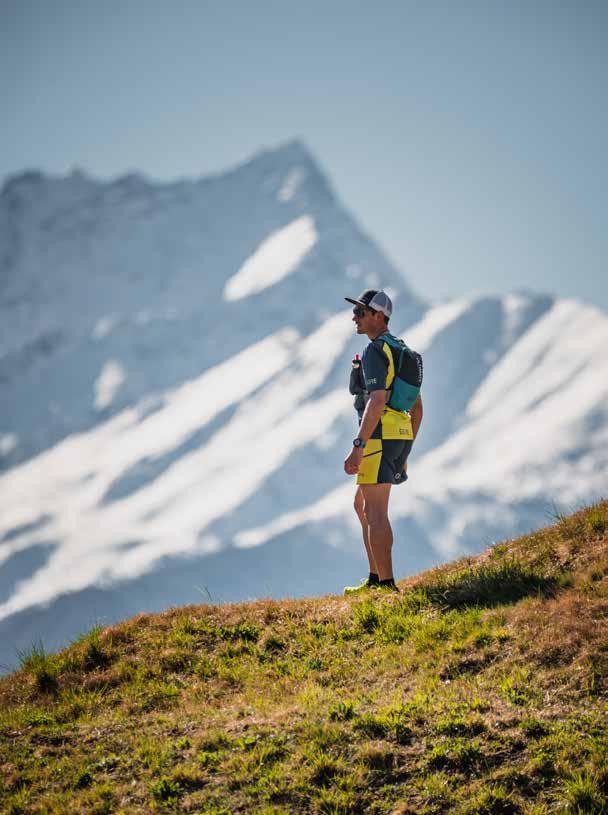
DA RAGAZZINO DANI JUNG INSEGUIVA LE MUCCHE SULL‘ALPEGGIO DEL NONNO, OGGI È LUI AD ESSERE INSEGUITO DAI MIGLIORI TRAIL RUNNER DEL MONDO.
Essendo uno degli ultra trail runner di maggior successo, Dani percorre distanze di oltre 100 chilometri, superando spesso migliaia di metri di dislivello. Dani Jung, classe 1983, vive e si allena a Naturno.
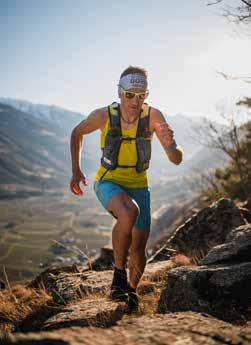
AS A LITTLE BOY DANI JUNG CHASED AFTER THE COWS ON HIS GRANDFATHER‘S MOUNTAIN PASTURE – TODAY HE IS FOLLOWED BY THE WORLD‘S BEST TRAIL RUNNERS.
As one of the most successful ultra trail runners, he runs distances of over 100 kilometers, often overcoming thousands of meters in altitude. The boy from Naturno/Naturns only came to this sport by chance, but from the beginning he was able to hold his own against experienced professionals and even set course records.
Peso: Your weight: 69 kg 150.000 Metri di dislivello per stagione? How many vertical meters do you do in one season?
Altezza: Your height:
1,74 m
Quanti chilometri? How many chilometers?
3.500
Quante scarpe da corsa consumi in una stagione? How many running shoes do you wear out in a season?
6 - 10
Tempo di avventura Adventure Time

ESCURSIONI Le numerose possibilità di escursioni offerte da Naturno, stuzzicano il desiderio di stare all’aria aperta: la funivia Unterstell, il Parco Naturale Gruppo di Tessa o le escursioni con i soffici lama. Se volete fare i veri alpinisti, potre te mettere alla prova il vostro coraggio sulla via ferrata Knott o nella palestra di roccia Juval .
CICLISMO Volete provare qualcosa di diverso dalle solite escursioni lungo i sentieri nei boschi? Provate con la mountain bike! Prima di avventurarvi sui sentieri, potrete migliorare la vostra abilità sulla mountain bike con le guide della Ötzi Bike Academy presso l’MTB Technology Park.
RAFTING Le estati a Naturno sono calde e il modo migliore per rinfrescarsi è cimentarsi con il rafting sull’Adige o sul Passirio. Chi ha provato a sedere assieme ad altri in un gommone e ha combattuto contro la forza primordiale dell’acqua, non potrà dimenticare questa emozionante esperienza.
PERCORSO PER TIRO CON L’ARCO 3D Quale miglior esercizio di consapevolezza del tenere un arco in mano, incoccare una freccia e rivolgere i propri pensieri al bersaglio? A Monte S. Catarina e Maso Corto si tengono corsi di tiro con l’arco in 3D, perfetti per testare il vostro talento di arceri.
FLYING FOX Il parco avventura Ötzi Rope Park di Vernago vi attende con una nuova attrazione: il Flying Fox! Con questi scivoli a corda - il più lungo è lungo 700 metri – potrete volare come uccelli, attraversando il bosco e sorvolando l’acqua.
HIKING Taking to the outdoors comes spontaneously in Naturno/Naturns. You can rely on the efficient Unterstell cable car to take you up into the heights of the Texelgruppe Nature Park, with its numerous hiking trails. Or maybe you’d rather fancy an excursion on a fluffy llama?
BIKING If the idea of hiking along the forest trails seems too boring, then why not head out on a mountain bike? Before the trip, you can hone down your skills at the Ötzi Bike Academy supervised by professionals at the MTB Technology Park.
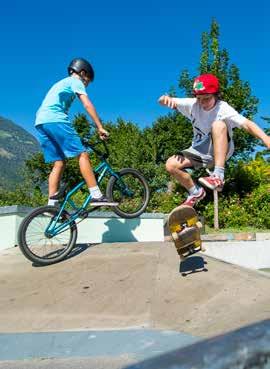
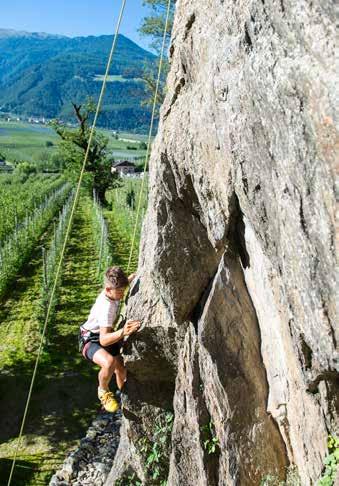
RAFTING Summers in Naturno can reach surprisingly high temperatures and rafting on the waters of the Etsch and Passer rivers is probably the best way to cool down. Squeezing into a rubber dinghy in a group and fighting the elemental force of the river current is a memorable experience!
3D ARCHERY RANGE With a bow in one hand and an arrow in the other, there’s nowhere better to do this than at the 3D Archery Range where your concentration is entirely focussed on the target. Test your hunting skills on the 3D archery ranges in Monte San Caterina/Katharinaberg and Maso Corto/Kurzras!


FLYING FOX With its a 700 m long rope slide, the highlight of the new high-rope course at the Ötzi Rope Park in Vernago/Vernagt is the “Flying Fox”. You can sail above the ground, over the forest and across the water like a bird (or a flying fox).

Imperiale! An Imperial Past
I GIARDINI DI CASTEL TRAUTTMANSDORFF SONO IL FIORE ALL’OCCHIELLO DI OGNI VACANZA IN ALTO ADIGE. IN UN ANFITEATRO NATURALE SONO RACCOLTI OLTRE 80 DIVERSI PAESAGGI NATURALI E CULTURALI, DIVERSI GIARDINI TEMATICI E NUMEROSE STAZIONI ARTISTICHE E D’AVVENTURA.
E, come se non bastasse quanto è ospitato in questo complesso di 12 ettari, Trauttmansdorff ha anche una magnifica vista su Merano. A proposito: Sissi, l’imperatrice Elisabetta d’Austria-Ungheria, amava Merano e soprattutto Trauttmansdorff. Nel 1870 si recò per la prima volta nella città del Passirio viaggiando sulla nuova ferrovia del Brennero in incognito, se così si può dire, visto che l’accompagnava una corte di 102 persone. Trascorse otto mesi a Castel Trauttmansdorff, che fu arredato così splendidamente soprattutto per il suo arrivo. La presenza di Elisabetta e, soprattutto, il rapido recupero della figlia malata Marie Valerie, furono i motivi per cui Merano divenne la città termale più popolare tra i nobili e i ricchi d’Europa.
WITH MORE THAN 80 NATURAL AND CULTURAL LANDSCAPES, INCLUDING THEMED GARDENS AS WELL AS ART AND ADVENTURE INSTALLATIONS, A VISIT TO THE TRAUTTMANSDORFF CASTLE GARDENS IS DEFINITELY ONE OF THE HIGH POINTS ON A HOLIDAY IN SOUTH TYROL.
Besides the spell-binding tour of the 12-hectare castle complex, there’s also a magnificent view over the spa town of Merano/Meran. Oh, by the way: The former Austro-Hungarian Empress (Elisabeth, nicknamed “Sisi”), loved going to Merano, especially to Trautmannsdorff Castle. On her inaugural trip in 1870, she travelled “incognito” (if that was at all possible with an entourage of 102!) on the newly commissioned Brennero/Brenner Train to spend eight months at Trauttmansdorff Castle. Elisabeth’s frequent stays in Merano and, above all, the rapid recovery of her ailing daughter, Marie Valerie, contributed significantly to Merano’s rise to prominence as the preferred spa town of the European nobility and moneyed elites.
I Giardini di Castel Trauttmansdorff ospitano un olivo di 700 anni proveniente dalla Sardegna. La circonferenza del tronco dell’albero coltivato è di 3 m, il suo diametro all’altezza del petto di 93 cm. The Gardens of Trauttmansdorff Castle is home to a 700-year-old olive tree from Sardinia. The circumference of the ancient tree is 3 meters; its diameter at breast height is 93 cm.
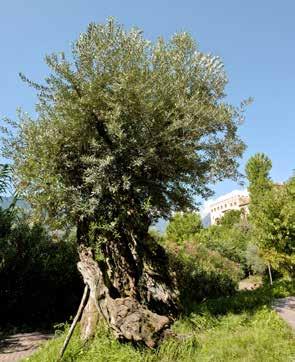

Specchio di ricordi Lake Resia and the sunken Town
IL CAMPANILE DEL LAGO DI RESIA È UNA DELLE IMMAGINI PIÙ SUGGESTIVE DELL’ALTO ADIGE, INSIEME A QUELLA DELLE ASPRE CIME DELLE DOLOMITI. QUESTA TORRE È SIA ATTRAZIONE SIA MONUMENTO COMMEMORATIVO, MENTRE SOTTO LE ACQUE BLU DEL LAGO SI NASCONDE LA STORIA DEL VILLAGGIO SOMMERSO DI CURON VECCHIA.
Nel 1939, un semplice manifesto in lingua italiana annunciò il progetto di fusione dei laghi di Resia, Curon e S. Valentino in un unico grande serbatoio di 22 metri di profondità. I disordini della seconda guerra mondiale ne ritardano l’attuazione, ma già dal 1947 più di 7000 persone lavorarono al serbatoio senza sosta. Nell’estate del 1950 le chiuse furono ultimate. Più di 100 famiglie, per lo più contadini e artigiani, dovettero assistere allo sgombero e all’esplosione dei loro masi. Solo il campanile, classificato monumento storico, viene risparmiato. Metro dopo metro l’acqua sommerse prati e campi. In quell’occasione alcune famiglie si allontanano per sempre dalla Val Venosta. Decenni dopo, le generazioni successive ha fatto i conti con il lago e la sua storia. E se il lago ormai è là, tanto vale sfruttarlo: per gli sport acquatici e il kitesurf, le escursioni a piedi e in bicicletta e come set fotografico tra i più popolari lungo la strada verso nord. In nessun altro luogo dell’Alto Adige la sofferenza e il piacere sono così strettamente collegati come a Curon sul lago di Resia.
TOGETHER WITH THE TOWERING PEAKS OF THE DOLOMITES, THE SOLITARY CHURCH STEEPLE EMERGING OUT OF THE RE SCHENSEE LAKE IS AMONG THE MOST EMBLEMATIC IMAGES OF SOUTH TYROL. YET THAT SAME STEEPLE ALSO SERVES AS A REMINDER OF A LESS EDIFYING PAST; BENEATH ITS LIMPID WATERS, THIS SCENIC MANMADE LAKE CONCEALS THE STORY OF THE FLOODED SETTLEMENT OF OLD CURON/GRAUN, WHICH LEFT A BITTER AFTERTASTE IN ITS WAKE.
In 1939, a short announcement in Italian prefaced the start of a massive hydro-electric project which involved merging the Reschensee, Mittersee and Haidersee lakes into a single reservoir, with a depth of 22 m. Although the turbulent events of WWII delayed its start, construction of the reservoir began in 1947 employing over 7,000 workers from all over Italy. The locks of the dam were finally closed in the summer of 1950 and over 100 families, mainly local farmers and artisans, were displaced when their houses and farms were cleared and destroyed to make way for the reservoir. The only remaining sign of Old Curon was the church steeple, subsequently designated as a historical monument. As the rising waters of the dam encroached on the Alpine fields and meadows, many families were forced to leave the Vinschgau Valley for good. Subsequent generations of South Tyroleans have slowly come to terms with the bitter-sweet legacy of this lake. Since it was already there, it become a mecca for water sports such as kitesurfing. With its hiking and biking trails, the lake area has developed into a popular beauty spot for tourists and holidaymakers on the south-bound route. Nowhere else in South Tyrol has its bitter-sweet legacy been so emblemised as at Curon on Reschensee Lake.

Hugo: Il fresco drink nato a Naturno Naturno and the Hugo
CHIUDERE LA GIORNATA TRA AMICI, CON UN RINFRESCANTE DRINK E QUALCHE STUZZICHINO: L’APERITIVO È UN FENOMENTO CULTURALE A SÉ. UNO DEI DRINK PIÙ FAMOSI È L’HUGO, CHE È STATO INVENTATO DA UN CREATIVO BARISTA DI NATURNO!
L’infaticabile gastronomo e spirito libero A. K. Gruber creò questo drink nel 2005, nel suo Bar San Zeno: volendo proporre un’alternativa all’Aperol Spritz diede vita a quello che, negli anni, è diventato un aperitivo di culto.
Ecco a voi la ricetta originale dell’Hugo di A. K. Gruber: 15 cl di Prosecco freddo, 2 cl di sciroppo di melissa, qualche foglia di menta e una spruzzatina di soda. Mescolare in un bicchiere da vino con cubetti di ghiaccio e guarnire con una fettina di limone.
ENJOY A CONVIVIAL GET-TOGETHER WITH FRESH DRINKS AND SNACKS TO ROUND OFF THE DAY. AN APERITIVO IS NOT JUST A DRINK, BUT A CULTURE IN ITSELF. ONE OF THE MOST FAMOUS APERITIFS IS THE HUGO – INVENTED BY A CREATIVE BARKEEPER IN NATURNO/NATURNS!
The bustling gastronome and free spirit A. K. Gruber created this summer drink in 2005 at his Bar San Zeno, and what was intended as an alternative to the classic Aperol Spritz developed into a refreshing cult drink over the years.
The recipe of the original Hugo after A. K. Gruber: 15 cl cooled Prosecco, 2 cl lemon balm syrup, some mint and a drop of sparkling water.
Colophon Imprint
EDIZIONE / ISSUE N o . 2
Editore / Publisher: Soc. Coop. Turistica Naturno / Tourism Board Naturno Concetto / Concept: Petra Götsch Articoli & interviste / Writing & interviews: Petra Götsch Traduzione / Translation: context Grafica / Design: id-creativstudio Stampa / Print: Lanarepro
Cover: PhotoGrünerThomas Foto / Images: Peter Santer, RoterRucksack.com, IDM Südtirol/Benjamin Pfitscher, Archiv Agentur für Bevölkerungsschutz/Stefano Benetton, Archiv Paul Grüner, VI.P Gen. landw. Gesellschaft, IDM Südtirol/trickytine, Maria Gapp, PhotoGrünerThomas, Patrick Schwienbacher, Seilbahn Unterstell, Hochseilgarten Ötzi Rope Park, Rafting Adventure Südtirol, Die Gärten von Schloss Trauttmansdorff, IDM Südtirol/Marion Lafogler, Emi Massmer Emotions
Partner:
Soc. Coop. Turistica Naturno Tourist Office Naturno Via Municipio 1 39025 Naturno Tel. +39 0473 666 077 info@naturns.it www.naturns.it










